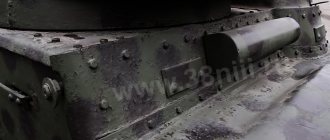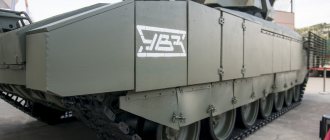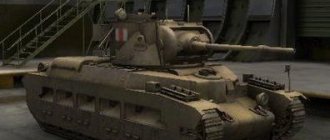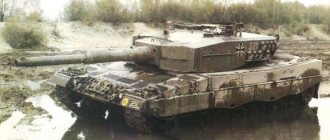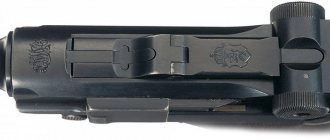Serial modifications of the MS-1 tank:
MS-1 (T-18) arr. 1927 - the hull and turret were riveted and assembled on a frame. The tower is hexagonal, with a mushroom-shaped observation turret. The engine was located across the body and was made in one block with the main clutch and gearbox. There was a “tail” at the rear of the hull.
MS-1 (T-18) arr. 1930 - turret with a rectangular aft niche, 40 hp engine. p., four-speed gearbox, cast drive wheel. Combat weight 5.68 tons. Dimensions 4350x1760x2120 mm. Ammunition: 104 rounds, 2016 rounds. Speed max. – 17.5 km/h.
Since 1929, MS-1 tanks began to enter service with newly formed mechanized units. They were actively used for training purposes - 103 vehicles immediately after production were transferred to the disposal of OSOAVIAKHIM and a number of military-technical educational institutions.
The MS-1 received its baptism of fire in November 1929 during the Soviet-Chinese armed conflict on the Chinese Eastern Railway. A separate tank company, numbering 9 combat vehicles, took part in the hostilities.
Since 1938, tanks began to be handed over to the URs on the western border of the USSR for use as both mobile and fixed (with the removal of the engine and chassis) firing points. At the same time, some of the combat vehicles were rearmed with a 45-mm tank gun mod. 1932
These tanks took part in the border battles of the summer of 1941, and in some cases, not without success. The latest facts about the combat use of the MS-1 relate to the Battle of Moscow. In particular, the 150th Tank Brigade in the winter of 1941/42 had 9 tanks of this type.
Tank MS-1 mod. 1927
Input circuit diagram
When measuring frequency, the quality of the input stage—the signal conditioner—is of great importance. It must have a high input impedance so as not to affect the measured circuit and convert signals of any shape into a sequence of rectangular pulses. This design uses a matching stage circuit with a field-effect transistor at the input:
This frequency meter circuit, of course, is not the best possible, but it still provides more or less acceptable characteristics. It was chosen mainly based on the overall dimensions of the structure, which turned out to be very compact. The entire circuit is assembled in a plastic toothbrush case:
Microcircuits and other elements are soldered on a narrow strip of a breadboard and all connections are made using MGTF type wires. When setting up the input stage of the signal conditioner, you should select resistances R3 and R4 to achieve a voltage of 0.1...0.2 volts at the source of the field-effect transistor. Transistors here can be replaced with similar, fairly high-frequency ones.
Tactical and technical characteristics of the MS-1(T-18) tank, model 1927:
- COMBAT WEIGHT, t: 5.3.
- CREW, people: 2.
- OVERALL DIMENSIONS, mm: length – 4400, width – 1760, height – 2120, ground clearance – 315.
- ARMAMENT: 1 Hotchkiss or PS-1 cannon of 37 mm caliber, 2 Fedorov machine guns of 6.5 mm caliber or 1 DT machine gun of 7.62 mm caliber.
- AMMUNITION: 96 rounds, 1800 rounds.
- AIMING DEVICES: diopter or 2.45x optical sight.
- RESERVATION, mm: front, side, rear and roof of the hull – 16, bottom – 8, turret – 16.
- ENGINE: special tank designed by A. Mikulin, 4-cylinder, 4-stroke, in-line, carburetor, air-cooled; power 35 l. s. (25.6 kW) at 1800 rpm, working volume 3200 cm3.
Troubleshooting a microwave oven
If the microwave oven has a digital display on which an error code appears in the form of the letter E with a number, then you need to find in the oven’s operating instructions what malfunction this code means. Perhaps, by following the instructions, you will not have to deal with serious repairs.
Attention! When repairing a microwave oven, care should be taken. Touching exposed parts of a circuit connected to an electrical outlet may result in electric shock. Do not forget to remove the plug from the socket and discharge the high-voltage capacitor when checking!
Before you start repairing the microwave oven yourself, you need to unplug the plug from the socket, unscrew several screws securing the cover and remove it by sliding it towards the rear wall of the oven.
Next, all parts and assemblies are carefully inspected for the presence of mechanical or thermal damage in the form of darkening. The tightness of the slip-on terminals is checked. If no visual defects are found, then according to the instructions in the table, troubleshooting is carried out.
| Table of common microwave oven malfunctions and ways to eliminate them | |||
| External manifestation of the malfunction | Possible cause of malfunction | Troubleshooting | Repair method |
| The oven does not turn on | The camera door is not closed tightly | Check the door | Close the door tightly |
| The timer handle rotates on the axis | Remove and check the handle for defects | Replace handle | |
| No voltage at the socket | Check for voltage | Connect any working electrical appliance to the outlet, for example, a table lamp | |
| The power cord is faulty | Visually check the plug and cord for mechanical damage, check the integrity of the cord wires with a multimeter | If faulty, replace the cord | |
| The electrical contact is broken at the connection point of the cord terminals in the surge protector | Check that the cord is securely connected to the filter and that there is no blackening or oxides. | If the contact is weak, tighten the union terminal with pliers; if there are oxides, clean the surfaces with sandpaper. If the terminals are damaged, replace them or solder the wires directly to the contact tracks of the printed circuit board | |
| Fuse F1 on the power filter board has blown | Check the fuse with a multimeter. If it breaks, ring with the door open (resistance should be zero) and closed (resistance should be infinity) contacts of the SWC limit switch | If the SWC is faulty, replace it, if it is not possible to remove the terminals from it and insulate it. Install a new F1 at the same current or repair it. If the new fuse blows, then you need to look for a short circuit in other components of the circuit | |
| Limit switch SWA or SWB faulty | Test the switches with a multimeter. When the door is open, the resistance should be equal to infinity, and when closed - zero) | If the switch malfunctions, replace it; if it is not possible, if only one of the two is faulty, remove the terminals from it and connect them together | |
| Mechanical damage to the movable bar with hooks on the door | Carry out an external inspection of the plank for damage. | Replace or repair depending on damage | |
| Mechanical timer or control unit is faulty | In a mechanical timer, you need to ring the contacts and check the operation of the motor. The electronic unit cannot be repaired independently | Clean the contacts or replace the faulty unit | |
| The display lights up, nothing happens when you press the buttons | The control unit is faulty or the contact pads of the buttons in the touch panel are dirty | Remove the control unit and wash the button contacts with alcohol | If this does not help, replace the control unit |
| The display lights up, the modes are set, but nothing happens when you press Start. | The Start button in the control unit does not work | Clean the touchpad contacts and buttons with alcohol. | In case of malfunction, replace the control unit |
| The switching relay in the control unit is faulty | Ring the relay coil and check the contacts | In case of malfunction, replace the relay | |
| When you press the Start button, the food does not heat up , but the fan and plate rotate, and the chamber lighting turns on | The high-voltage fuse is blown, the power transformer, high-voltage capacitor, diode or magnetron is faulty | Check the fuse, power transformer, high-voltage capacitor, diode and magnetron with a multimeter | Replace the faulty part |
| In modern stoves, the inverter or magnetron has burned out | Identify the faulty unit by replacing it | Replace the inverter or magnetron | |
| Microwave doesn't heat well | The FM fan does not work, the magnetron overheats and the protective thermal relay trips | Check the ease of rotation of the fan impeller with your hand and check the integrity of its windings with a multimeter | Lubricate the fan shaft with machine oil; if the winding breaks, replace the fan |
| Low line voltage or loss of magnetron emission | Measure network voltage | If the voltage is normal, replace the magnetron | |
| The oven does not turn off after the timer runs out | Timer is faulty | Check the timer gear mechanism | Replace timer |
| The food plate does not rotate | The plastic coupling is worn out | Remove the plate and inspect the coupling for damage | If defects are found, replace the coupling |
| The plate rotation motor is faulty or its power supply circuit is broken | Check by hand the free rotation of the shaft and ring the winding | If the rotation is tight, lubricate the shaft bearing; if the winding breaks, replace the motor | |
| Dirt has accumulated under the plate | Remove the plate and inspect | Remove dirt | |
| When heating food, a cracking sound is heard from the chamber and light discharges are observed | The mica plate insulating the magnetron waveguide burned out | Inspect the mica plate for defects (darkened area, hole). The plate is located on the right side of the stove chamber | If defects are found, replace the plate. The mica plate serves to protect electronics from food vapors. If there is no replacement, then you can temporarily reheat food without it |
| The camera stopped lighting | Burnt out light bulb | Check the light bulb and the reliability of fixation of the slip-on terminals on the socket terminals | Replace the light bulb or tighten the terminals with pliers |
Checking the contacts of wires and other parts is standard and does not cause difficulties. Checking the magnetron, high-voltage capacitor and diode has some features.
Checking the high voltage diode (pillar)
The design of a high-voltage pole consists of several low-voltage diodes connected in series, so it is not always possible to test them with a multimeter. The voltage drop on one simple diode is about 0.8 V, and when several are connected in series, the voltage drop is the sum of the drops on each in the chain and the multimeter voltage is not enough.
Therefore, to reliably check a high-voltage column, you need to connect an incandescent lamp of any power in series with it, as shown in the diagram. Using a cord with a plug, apply 220 V mains voltage from the outlet to the chain. The polarity of the diode connection does not matter.
If the lamp flickers and shines at full intensity, then the diode is working. If it is at full heat or does not light up, then the diode is broken or broken and, therefore, faulty.
Checking the high voltage capacitor
To check, you need to disconnect the capacitor from the microwave oven circuit and test them with a multimeter. Before checking, be sure to discharge it, so as not to damage the device, by shorting its terminals with a piece of wire with stripped ends.
Often a high-resistance resistor of 1-10 MOhm is installed inside the capacitor to discharge the capacitor. Therefore, the resistance when checking should be more than 1 MOhm. If less than or equal to zero, then the capacitor is faulty.
You can check the capacitor without a device and in a more reliable way, described above for a high-voltage diode. Instead of a diode, a capacitor is switched on. The power of the incandescent light bulb is selected from 60-150 W.
If the capacitor is working properly, depending on the power of the lamp, its brightness will be lower than usual. The more powerful the lamp, the lower the brightness of its glow will be. The capacitor in this circuit acts as a current limiter. If the brightness of the lamp does not decrease or the lamp does not light up, it means that the capacitor is broken or broken.
Checking the magnetron and thermal fuse
Testing a magnetron is no more difficult than testing a diode or capacitor. First, the resistance of the filament is measured with a multimeter, the value of which should be 3-10 ohms.
The resistance between the anode and cathode of the magnetron is then measured. To do this, just touch the ohmmeter probes between any filament terminal (cathode) and the magnetron housing (anode). Resistance must be endless.
If the resistance of the filament is infinity, or zero between the anode and cathode, then the magnetron is faulty and must be replaced.
The resistance of the thermal fuse must be zero; if it is greater, then it is faulty and must also be replaced, since it cannot be repaired.
If you don’t have an ohmmeter, you can check the magnetron, like the diode, using a light bulb. When you turn on the magnetron filament instead of the diode, the light bulb should glow at full intensity, the anode and cathode should not glow. Thermal fuse - lights up.
Fading, wash and other effects
The subsequent stages of painting the T-18 tank model fascinated me quite a lot and, unfortunately, I constantly forgot to take intermediate photographs of the model 
The sequence of actions was as follows:
Gloss varnish in two layers with intermediate drying.
Applying decals. I used vinegar, as always - excellent results. After applying the decals, another coat of gloss varnish is applied on top of them.
Decals for T-18
Oil spots (fading, weathering). I used yellow, white, green and brown oil paint. Yellow gives the green base a warmer, more complex tone. A very interesting result is obtained.
Dark brown wash , mixed independently from oil paints and white spirit.
For the effects of mud streaks I used the same oil and some effects from Model. Lab." — I liked working with them.
Effects Model Lab
The resulting result was covered with matte varnish from Tamiya . I noticed a peculiarity that the more you dilute it with thinner, the less matte the result becomes. Try to dilute it as little as possible.
I noticed a peculiarity that the more you dilute it with thinner, the less matte the result becomes. Try to dilute it as little as possible. Well, you can’t always get by with one layer either. As a result, I didn’t receive a “silent swear word”, and I didn’t really want it. After all, the tank is made of metal, not wood.
Well, you can’t always get by with one layer either. As a result, I didn’t receive a “silent swear word”, and I didn’t really want it. After all, the tank is made of metal, not wood.
The tracks were first dry brushed with X-11 Crome Silver. For contamination I used pigments from ZIP layout and Model Chem Product .
I decided not to dirty the model too much with pigments. According to legend, the tank is not new, but “washed” and has not been driven through mud since then. In general, the paint has weathered a little and the bottom is a little dusty.
Added the effect of spilled fuel in the area of the gas tank necks. I used Diesel exshaust runs effects from Wilder .
Diesel exshaust runs effects by Wilder
Headlight - Elf Set
